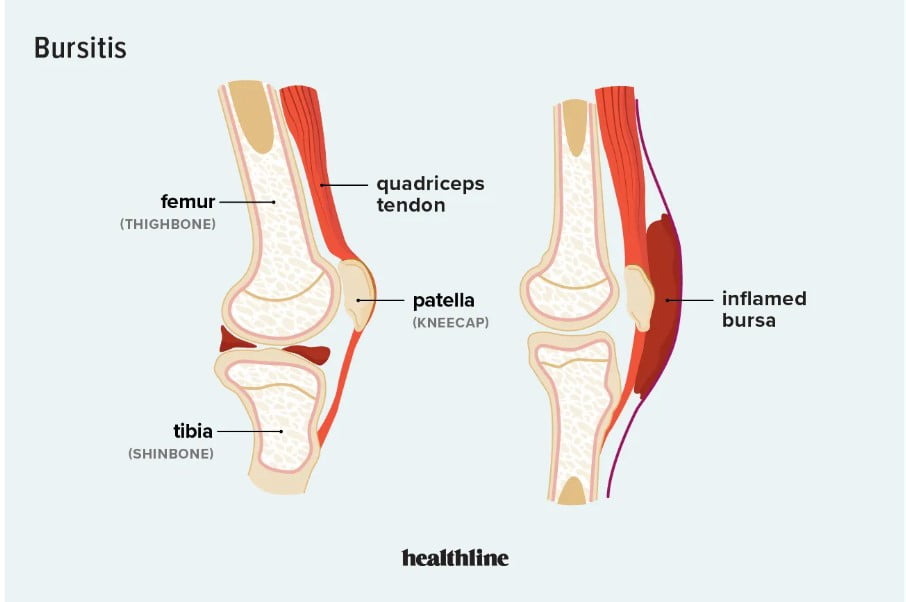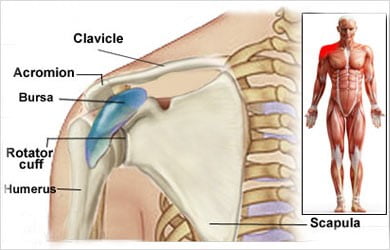Bursitis occurs at joints that perform repetitive motion in the body. It appears in the form of painful inflammation of a few of the 150 bursas. The synovium-lined fluid-filled sacs cushion the bones and act as a gliding surface to reduce tissue frictions. At least 1 out of 10,000 people develop the condition on their knees and elbows annually.

Image Source: https://www.healthline.com/health/bursitis
Another fairly common location is the shoulder where you may experience a reddened warm sheath. It is a ‘disabling complaint’ and the reported yearly incident is 14.7 per 1,000 patients. This is especially seen in adults after age 40 due to high-pressure activities like raking, shoveling, skiing, tennis, scrubbing and carpentry.
The lifetime prevalence of shoulder pain maybe 70%. The number one cause is said to be rotator cuff tendonitis or bursitis. Biceps tendonitis might travel from the front of the upper arm to the shoulder socket top and get irritated. Patients experience fever, general illness or extreme trouble moving the joint. The good news is that there are ample ways to relieve subacromial or shoulder bursitis. Here’s a look.
1. Ice Therapy
This is useful if the injury is caused by sudden pain. It will decrease the blood flow that reduces swelling around your joint and keep it from feeling stiff. The area feels numb which eases the pain. Else, bursitis will reduce mobility and cause more serious shoulder pain followed by tension headaches.
Here’s what to do:
- Apply for 10 to 15 minutes at a time.
- Place a thin cloth in between the ice cubes and the skin.
- It can be as often as twice an hour for 3 days.
The point prevalence of shoulder pain is 26% and is linked to rotator cuff lesions. So, follow icing with pain relievers for the best results. You may also talk to a physician in New Jersey who can carefully craft a program for your pain management.
2. Elevate the Area
Raising the painful part can minimize pressure in the local blood vessel. This limits bleeding and increases the drainage of ‘inflammatory exudate’ via lymph vessels. It can reduce and limit the edema and exhibit symptomatic improvement.

Image Source: https://www.medindia.net/patients/patientinfo/bursitis.htm
Keep the injured part above the level of your heart whenever possible. Painkillers and non-steroidal anti-inflammatory drugs, creams and tablets can be used to ease the discomfort. Consult your doctor before considering ibuprofen or acetaminophen to cut downside effects.
3. Avoid Activities
Lying down, walking long distances or simply sitting in one position continuously can worsen bursitis. Stay away from activities that may cause direct pressure on the shoulder and engage the muscles. It will include lifting, pulling, carrying and holding. Avoid swinging the arm or moving it in circles rigorously which can make you highly uncomfortable. But light stretches can help relieve the pain and tightness in the shoulders. Get in touch with your healthcare expert to learn a few range-of-motion exercises using light dumbbells.
4.Use a Splint
This is robust support made from plastic, plaster or metal. It can protect an immobilized, injured and swollen body part. The global orthopedic splint market size was valued at $1.45 billion in 2020 and is expected to grow at a CAGR of 8.9% by 2028. These figures are driven by the rising cases of bone fractures across the world. A splint keeps the area from moving if you have pain that disturbs sleep. They are also best used during flare-ups occasionally during the day when the shoulders might be in pain.
5. Apply Heat
Heat can soothe a stiff shoulder by relaxing the tensed muscles. You may consider a heated gel pack, hot water bottle or a heating pad. But make sure not to apply on swelled-up areas, new injuries or anywhere that is sweating. Icing should be the first priority to reduce the bump. This should be followed by heat but not on torn muscles. The blood flow is increased which ultimately speeds up the overall healing process. Use the pad for no more than 20 minutes at a time to avoid adverse impacts like burning sensations.
Pain treatment protocols are unique to each patient. So, it is a good idea to work in close collaboration with your doctor. They assess your lifestyle and the kind of work you do to provide the best treatment possible. Add plenty of Vitamin C, Omega-3 fatty acids and bromelain to your diet to help reduce inflammation.





